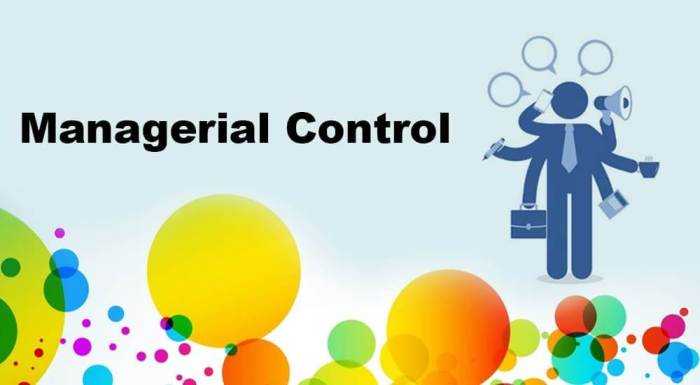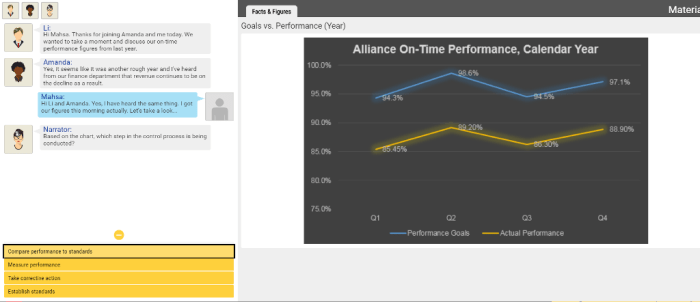Managerial control: a turbulent ride takes center stage, inviting us to delve into the intricacies of organizational governance in the face of unrelenting change. This exploration promises to unravel the complexities of managerial control systems, revealing their significance in steering organizations through the tempests of a rapidly evolving business landscape.
As we embark on this journey, we will dissect the challenges that organizations confront in implementing managerial control systems amidst constant flux. We will also examine how organizations can adapt their control systems to embrace uncertainty and metamorphosis. Technology’s role in enhancing managerial control will be brought to light, showcasing how organizations leverage its capabilities to refine their control processes.
Managerial Control

Managerial control refers to the processes and mechanisms implemented by organizations to ensure that their activities are aligned with strategic objectives and that resources are utilized effectively and efficiently. It involves monitoring performance, identifying deviations from plans, and taking corrective actions to maintain organizational stability and progress.
Managerial control systems are crucial for ensuring accountability, transparency, and optimal decision-making within organizations.
Types of Managerial Control Systems, Managerial control: a turbulent ride
Organizations employ various types of managerial control systems to suit their specific needs and operating environments. Some common types include:
- Financial controls: These focus on monitoring financial performance, ensuring compliance with accounting standards, and safeguarding assets.
- Operational controls: These focus on ensuring that daily operations are conducted efficiently and effectively, with an emphasis on quality control, process optimization, and adherence to established procedures.
- Compliance controls: These focus on ensuring that organizations comply with external regulations and internal policies, such as ethical guidelines, environmental standards, and data privacy laws.
- Strategic controls: These focus on monitoring the implementation of strategic initiatives, assessing progress towards long-term goals, and making adjustments as needed.
Effective managerial control systems provide organizations with a framework for achieving desired outcomes, enhancing operational efficiency, and mitigating risks.
The Challenges of Managerial Control in a Turbulent Environment

Organizations in the contemporary business landscape confront a plethora of challenges in implementing managerial control systems amidst rapid and unpredictable changes. The turbulent environment poses significant obstacles that can hinder the effectiveness of traditional control mechanisms and necessitate innovative approaches.
One of the primary challenges lies in the heightened uncertainty and volatility of the external environment. Rapid technological advancements, globalization, and changing customer preferences create a highly dynamic landscape where assumptions and forecasts become obsolete quickly. This volatility makes it difficult for organizations to establish stable control parameters and renders traditional budgeting and planning processes less effective.
Impact on Organizational Performance
- Ineffective control systems can lead to poor decision-making, misallocation of resources, and missed opportunities.
- Failure to adapt control systems to the changing environment can result in organizational inertia and reduced competitiveness.
- Outdated or inappropriate control mechanisms can stifle innovation and hinder the organization’s ability to respond to new challenges.
Adapting Managerial Control to a Turbulent Environment
In today’s rapidly changing business landscape, organizations face unprecedented uncertainty and volatility. To thrive in this turbulent environment, companies must adapt their managerial control systems to cope with uncertainty and change.A flexible and responsive control system is crucial for organizations to navigate the complexities of a turbulent environment.
Organizations must continuously monitor their internal and external environments, identify potential risks and opportunities, and adjust their control systems accordingly. This requires a shift from traditional, rigid control systems to more adaptive and dynamic approaches.
Best Practices for Designing and Implementing Flexible Control Systems
- Embrace Continuous Monitoring:Establish a system for ongoing monitoring of both internal and external factors that may impact the organization’s performance.
- Foster Agility and Flexibility:Design control systems that allow for quick and efficient adjustments in response to changing circumstances.
- Encourage Innovation and Risk-Taking:Create a culture that encourages employees to take calculated risks and experiment with new ideas, while still maintaining appropriate levels of control.
- Leverage Technology:Utilize technology to automate control processes, improve data collection and analysis, and enhance the overall effectiveness of the control system.
- Communicate and Collaborate:Ensure clear and effective communication between management and employees regarding the purpose and importance of control systems, and foster collaboration in the design and implementation process.
The Role of Technology in Managerial Control

In a turbulent environment, technology plays a pivotal role in enhancing managerial control. By leveraging technological advancements, organizations can gain real-time visibility into operations, automate control processes, and improve decision-making.
Real-Time Visibility
Technology enables organizations to collect and analyze vast amounts of data from various sources, providing real-time insights into operations. This allows managers to identify potential risks and opportunities early on, enabling proactive decision-making.
Automation of Control Processes
Automation tools can streamline control processes, reducing manual errors and improving efficiency. For instance, automated data validation systems can ensure data accuracy, while workflow automation tools can enforce control procedures consistently.
Improved Decision-Making
Technology provides managers with access to advanced analytics and reporting tools. These tools enable them to analyze data, identify trends, and make informed decisions based on real-time information. This enhances the quality and timeliness of managerial decision-making.
Examples of Technology Usage
- Walmart uses RFID technology to track inventory in real-time, improving supply chain visibility and reducing shrinkage.
- Amazon employs artificial intelligence (AI) algorithms to detect and prevent fraud, ensuring the integrity of its e-commerce platform.
- Netflix utilizes data analytics to personalize content recommendations, enhancing user engagement and revenue generation.
The Human Element of Managerial Control
In a turbulent environment, the human element plays a critical role in managerial control. Human judgment and discretion are essential for adapting to changing circumstances, making timely decisions, and ensuring effective implementation of control systems.
Challenges and Opportunities
The human element presents both challenges and opportunities in managerial control. On the one hand, human judgment can be subjective and prone to biases, which can lead to errors in decision-making. On the other hand, human discretion allows for flexibility and adaptability, which are crucial in a turbulent environment.
Managers must balance the need for objectivity and consistency with the need for flexibility and innovation.Additionally, the human element can be a source of resistance to change. Employees may be reluctant to adopt new control systems or procedures that they perceive as threatening or disruptive.
Managers must address these concerns and actively engage employees in the implementation process to ensure their buy-in and support.Despite these challenges, the human element is also a valuable asset in managerial control. Human judgment and discretion can help managers identify and address emerging risks, make informed decisions, and adapt control systems to the specific needs of the organization.
By leveraging the human element effectively, managers can enhance the effectiveness of managerial control and improve organizational performance in a turbulent environment.
Case Studies of Managerial Control in Turbulent Environments: Managerial Control: A Turbulent Ride
Organizations operating in turbulent environments face unique challenges in implementing and maintaining effective managerial control systems. This section presents case studies of organizations that have successfully navigated these challenges and achieved positive outcomes.
Case Study: Apple Inc.
Apple Inc. is a technology giant known for its innovative products and strong financial performance. The company has implemented a comprehensive managerial control system that enables it to respond effectively to the rapidly changing technology landscape.
Key strategies employed by Apple include:
- Centralized decision-making:Apple’s leadership team retains ultimate authority over major decisions, ensuring alignment with strategic objectives.
- Data-driven insights:The company leverages data analytics to inform decision-making, providing real-time visibility into performance and enabling proactive adjustments.
- Flexible and adaptable systems:Apple’s managerial control systems are designed to be flexible and adaptable, allowing the company to respond quickly to changes in the external environment.
Clarifying Questions
What is managerial control?
Managerial control refers to the processes and mechanisms implemented by organizations to ensure that their activities align with strategic objectives and desired outcomes.
Why is managerial control important in a turbulent environment?
In a turbulent environment characterized by rapid change and uncertainty, managerial control becomes crucial for organizations to maintain stability, adapt to new circumstances, and achieve their goals.
How can organizations adapt managerial control to a turbulent environment?
Organizations can adapt managerial control to a turbulent environment by designing flexible and responsive control systems that can quickly adjust to changing conditions and provide timely and relevant information for decision-making.